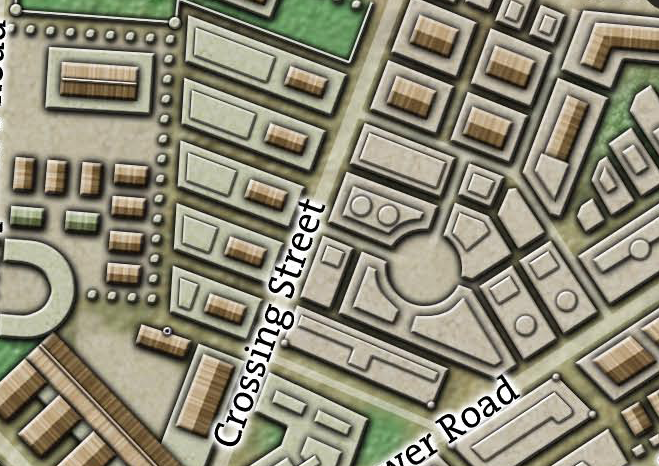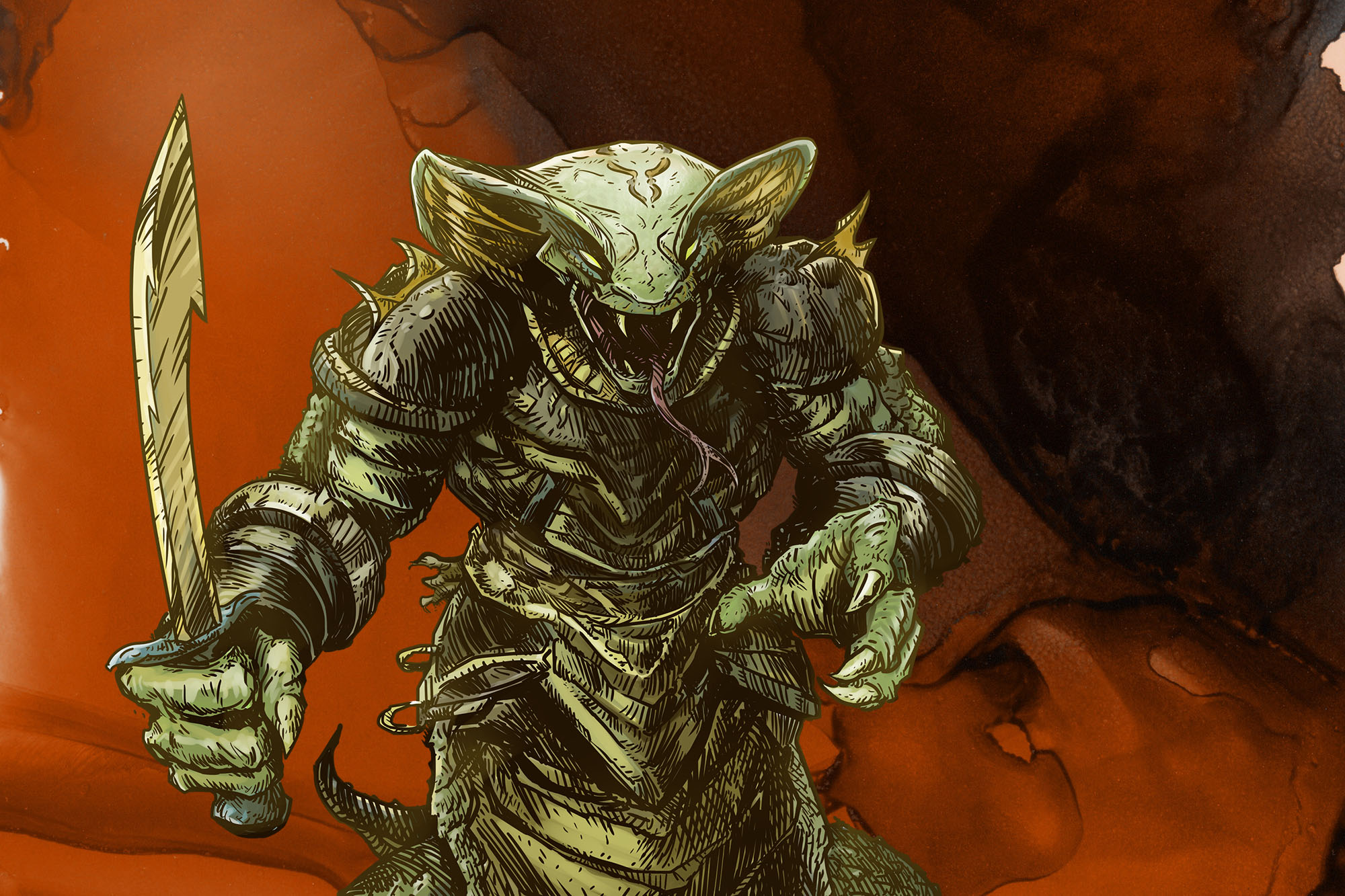The Vladaams own a block of apartments in Oldtown on Crossing Street, which are primarily as housing for members of the Vladaam deot. Recently, as detailed in the “Temple of Deep Chaos” adventure in The Night of Dissolution, a chaos cult took control of one of the buildings and used it as a site for testing and developing askara, a potent magical poison which turns its victims into venom-shaped thralls.
A few weeks ago, a party of adventurers cleaned out the chaos cultists and did their best to destroy the cultists’ research. The building was sealed for a time by the city, but then reclaimed by the Vladaams. Members of the Red Company of Magi moved in to figure out what the chaos cultists had been doing, and the project was quickly taken over by Aliaster Vladaam.
During this same time, Navanna Vladaam became aware that the Banewarrens had been breached (as described in Chapter Four of the Banewarrens campaign). She began mounting expeditions into the Banewarrens and began bringing the “banes” she liberated to the Oldtown Apartment so that they, too, could be studied by Aliaster in the labs he’s established here.
DESIGN NOTES & BACKGROUND
This is a tricky location. As presented here, it reflects both the actions the PCs in my group took when raiding the apartment building and how events played out in the Banewarrens (thus determining, for example, which banes Navanna was able to bring back here). I prepped the following timeline for how events played out here:
- 09/22: The “outraged” Vladaams force the city watch to remove their quarantine on their apartment complex.
- 10/06: Navanna brings the body of the pain demon here from the Banewarrens.
- 10/10: The Vladaam Pain Devil Research notes are added to area 6.
- 10/10: Contents of BW05 weapon vaults brought here by Navanna.
- 10/15: Aliaster duplicates the hell scourge & agony’s caress abilities of the pain devil. Four of the Twelve Claws gain hell scourge grafts (including the two guarding the front door).
If you’re running The Vladaam Affair independent of one or both of these other campaigns, you can just assume that an NPC party of adventurers raided the Temple of Deep Chaos and got Navanna involved with the Banewarrens. (Or, alternatively, maybe the Temple of Deep Chaos is still located beneath the apartment building, unknown to the Vladaams and filled with chaos cultists preparing to take back what the Vladaams have taken from them.)
If, on the other hand, your PCs are also playing through one or both of those adventures, you’ll want to modify the adventure key here to reflect how events actually played out (and are playing out) at your table.
Either way, you’ll likely want to review the original key describing this building in Night of Dissolution.
It’s also worth noting that overly curious PCs might be able to track Navanna and/or the banes here back to the Banewarrens. That could present a novel opportunity for the PCs to get involved with the Banewarrens campaign, but if that doesn’t interest you, you might want to provide an alternative source for the magic items Aliaster is studying.
Also of note is that the other apartment buildings in the block are still inhabited by various members of the Vladaam deot (who are largely or entirely unaware of what’s going on next door). If the PCs are tracking a member of the deot or looking for a Vladaam to question, their target could easily be a tenant of this apartment block.
Oldtown
Crossing Street – D4
DENIZENS
During the day there is a 60% chance that Aliaster Vladaam (Ptolus, p. 101) is present conducting research. If he’s present, there’s a 10% chance that another member of the family (Navanna, Gattara, or Godfred) is there – either to check up on him, collaborate with him, or just to see what all the fuss is about.
Aliaster will run at the first sign of trouble (using teleport to get out), but if other family members are present things could get ugly.
DENIZENS - NIGHT Location
Hell-Scourged Claws (x2) Front Door
DENIZENS - DAY Location
Hell-Scourged Claws (x2) Front Door
Vladaam Researchers (x4) Second Floor
Vladaam Researcher: Use acolyte stats, MM p. 342. See Part 13: Red Company of Magi.
Hell-Scourged Claws: The Twelve Claws are Navanna’s werewolf agents (see Ptolus, p. 101 and Part 5: The Vladaam Estate). Aliaster has reverse-engineered a pain devil’s hell-scourge (see Area 6, below) and grafted them onto
- Hell-Scourge. Melee Attack Roll: +6, reach 5 ft. Hit: 15 (2d8+6) slashing damage.
- Flurry of Steel. As a bonus action, a hell-scourged claw can make two attacks with their hell-scourges.
- Agony’s Caress. As a bonus action, a hell-scourged claw can send elemental pain cascading through the scourge. Those struck by a hell-scourge must make a DC 12 Constitution saving throw. On a failure, the target becomes Restrained as their body is wracked with pain beyond imagining.
FIRST FLOOR
All of the cocoons and nests on this level have been removed to the second floor. Crude buttresses have been erected using wall of stone to reinforce the weakened floors of the upper level. The holes punched in the ceiling have also been repaired.
AREA 1 – ENTRANCE
Furnished with simple, badly dilapidated and blood-stained furniture: Tables, chairs, and a pair of divans.
AREA 1A – STONE BUTTRESSES/PATCHED CEILING
A large hole in the ceiling of this room has been patched and a wall of stone has been used to support the floor and walls.
AREA 1B – STONE BUTTRESSING
This room also contains a wall of stone used to reinforce the upper floor.
AREA 2 – FORMER APARTMENT
This room was destroyed by venom-shaped thralls. It has been left in a broken shambles.
AREA 3 – FORMER INJECTION ROOM
A large wooden table stand sin the middle of an otherwise barren room.
AREA 4 – FORMER PRISON
DOOR (Strong Wood): AC 15, 27 hp, DC 20 Dexterity (Thieves’ Tools). Unlocked currently, but could be secured.
Smeared feces on the wall.
AREA 5 – THE HOLE
A hole in the corner of the room has been boarded over.
TRAP IN THE SHAFT: Below the boards is a shaft leading to the sewers. Anyone climbing through the shaft will trigger a flame strike that will fill the shaft and column above and below it, inflicting 4d6 fire damage and 4d6 radiant damage. DC 14 Dexterity saving throw for half damage.
- DC 20 Intelligence (Investigation), DC 24 Dexterity (Thieves’ Tools)
AREA 6 – PAIN DEVIL RESEARCH ROOM
The body of a pain devil is laid out and dissected on a worktable in the center of the room.
PAIN DEVIL (as it would appear in life): Skin of glistening ebony. Eyes a blood-red crimson. Mouth a toothless maw with razored lips. Chains are fused about its wrists, each animate with hatred.
- The body is remarkably well-preserved in death (although now vivisected). Note that the animate chains have been burnt away, leaving only charcoaled stubs on the creature’s wrists.
RESEARCH: Papers arranged on the worktable constitute the Vladaam Pain Devil Research.
GM Background: I added a pain devil to one of the Banewarrens vaults, further modifying it so that its hell-forged scourges were grafted to its wrists. The PCs in my campaign freed it, fought it, and killed it. Navanna Vladaam retrieved the corpse and brought it here. D&D 5th Edition stat blocks for a pain devil can be found in Chains of Asmodeus, p. 249.
VLADAAM PAIN DEVIL RESEARCH
These research notes describe an autopsy and magical dissection.
GROSS CHARACTERISTICS
- Pitch black skin with scabrous patches of gem-like glistering. The flesh appears resistant to decay, but there is an intermittent degradation of its luster.
- The vitreous humour of the eye appears to be filled with blood, but not of the creature’s own. Origin of the blood is uncertain, but appears to be integral to the function of the eye.
- Body does not possess teeth, but instead several ranks of razor-sharp lips capable of independent motion along a horizontal plane.
- Charcoaled stubs on the creature’s wrists appear to be the remains of biometallic chains or possibly lashes. Beneath the stubs are receptor sites triggered to serve as channels of emotional extremity.
- Nystulean worms react with stress when placed within the creature’s transluminal aura. Despite the body having been deceased for days or possibly weeks, the strength of this lingering aura of pain and hatred is intense. During life it may have actually been capable of inflicting physical duress.
Additional preliminary notes are given, hypothesizing ways in which the biomagical properties of the creature could be reverse engineered and applied.
AREA 6A – WEAPONS RESEARCH
Multiply display cases for weaponry have been installed around the periphery of the chamber.
WEAPONS: These weapons are tainted. They were retrieved from the Banewarrens (Outer Vaults — Area 11). The weapons all have a Forge Mark on them.
- +1 battle axe
- +1 greatsword
- +1 longsword
- +1 mace
- +1 unholy shortsword
- +1 scimitar
- +1 greataxe
- +1 longbow
- dagger of venom
- sword of life stealing
GM Background: Although these weapons are being studied by Aliaster, there’s actually little of interest about them other than historical curiosity.
FORGE MARK: Worked in red gold and ebony, this forge mark indicates that these weapons were wielded by the Legion of Bhor Kei.

AREA 7 – COCOON/NEST RESEARCH
The remains of three venom-shaped thrall cocoons and four nests (most severely burnt) have been gathered in this room. There are also samples from an osyluth cocoon taken from the Banewarrens (Outer Vaults — Area 4).
AREA 8 – SECONDARY ALCHEMY LAB
DOOR (Steel-Cored): AC 19, 40 hp, DC 18 Dexterity (Thieves’ Tools). Can be barred from the outside, but is not generally secured.
A secondary alchemical laboratory has been set up here to study the specific remains of the unusual nest that was in this area (the victim became a protoplasmic goo similar to a gibbering mouther, see Night of Dissolution).
- The researchers have discovered strength-boosting alchemicals in the burnt remains of the nest and are attempting to isolate them.
DRAUGHTS OF MORPHEUS: Letter from Grui to Aliaster attached to a black ebon box lined with purple velvet. Designed to hold eight bulbs of thick, black oil; it currently holds five. (These are draughts of Morpheus.)
GM Background: The researchers here have been using draughts of Morpheus to work even longer hours.
LETTER FROM GRUI TO ALIASTER
Milord Aliaster the Wise—
Please accept these Draughts of Morpheus with the most sincere compliments of your sister. If you should have need of any further aids to your work or workers, do not hesitate in your request.
Grui
Master of the Alchemical Laboratories
upon the Brewer’s Close
AREA 9 – PRIMARY ALCHEMICAL LABORATORY
The primary alchemical laboratory has been erected here. Two sets of cocoons and nests are in various states of deconstruction, with various alchemical solutions being applied in an attempt to restimulate growth.
NOTE ON NECESSARY ALCHEMICAL SUPPLIES
We’ll need a fresh supply of Naiad’s Tears if we’re going to prevent the cross-contamination endemic in this fecund material.
Also—I have an urgent need for Serenity Draught. It seems to be of great use in easing the side effects of the hell-scourge grafts currently suffered by Navanna’s wolves.
Send word to the lab on Guilder Street and lay in a goodly supply of both… and perhaps a word about the efficacy of the Serenity Draught should be sent along to Brewer’s Close.
-Aliaster
VLADAAM ASKARA RESEARCH NOTES
These research notes describe ongoing studies of the “severely charcoaled organic remains” found in the Oldtown apartment complex. The goal of the research is clearly an attempt to reconstruct the “mutagenic and metamorphic compounds used to create the hybridized morphologies.”
In other words, the researcher clearly does not know the term askara and the research is an attempt to reconstruct its properties. To this end, they have dissected and analyzed various tissue samples and are now in the process of applying various alchemical substances in an effort to “reinvigorate growth.”
GM Note: This handout is written for PCs who participated in the vents of Night of Dissolution and are familiar with the term “askara” and, broadly, what the cultists were trying to accomplish. If that’s not the case in your campaign, you’ll want to rewrite the handout appropriately or present the information in a different way.


















